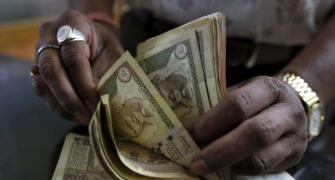
Officials grappling with a combination of measures to provide spending buffer
The challenging fiscal math for the upcoming year on account of higher expected outgo on salaries and pension has prompted the government to examine various permutations and combinations to check the feasibility of curtailing the deficit to 3.5 per cent of the gross domestic product.
When Finance Minister Arun Jaitley presents the Union Budget 2016-17 on February 29, the focus of policy watchers, analysts, markets and ratings agencies will be on whether the fiscal deficit target of 3.5 per cent is stuck to or not.
The range of recommendations that could collectively give the government enough resources to narrow the fiscal deficit by 0.4 percentage points from 2015-16 to 2016-17 include staggering the hike in pension but not pay and deferring the house rent allowance hike under the Seventh Pay Commission recommendations, pushing strategic sales of ‘sick’ state-owned companies and raising service tax rate from 14 per cent to 16 per cent.
The higher salaries and pension outgo will be equivalent to about one per cent of the GDP.
“Serious thought has gone into various recommendations that suggest that it may be possible to narrow the fiscal deficit to the existing fiscal responsibility and budget management target.
It will no doubt be a challenge as government capital spending will remain high, but a combination of measures can provide us enough buffer,” said a government official.
According to the suggestions, deferring the HRA will provide the government with fiscal space of 0.15 per cent of the GDP.
Deferment is based on the fact that the house rents have remained flat on account of muted real estate market. Staggering the pension under the SPC is estimated to provide government with 0.3 per cent of the GDP, while service tax increase by two percentage points could lead at space of another 0.2 per cent.
Service tax was hiked to 14 per cent from 12.36 per cent in 2015-16, which along with excise duty hikes has been the major revenue source for the government, facilitating the narrowing of fiscal deficit to 3.9 per cent of the GDP despite lower than estimated nominal GDP.
Jaitley has announced that he will make a provision of Rs 1.1 lakh crore (Rs 1.1 trillion) in the next financial year to implement the recommendations of the SPC and the One Rank One Pension scheme.
The SPC’s recommendation of a 23.55 per cent increase in the pay and allowances of government employees from January 1, 2016, will need an estimated Rs 1.02 lakh crore (Rs 1.02 trillion) extra expenditure, of which Rs 73,650 crore (Rs 736.5 billion) will be borne by the Union Budget and Rs 28,450 crore (Rs 284.5 billion) by the Railway Budget.
The Sixth Pay Commission recommendations in 2008-09 contributed to the widening of fiscal deficit to six per cent of the GDP as against the targeted three per cent.
The Defence pension Budget is likely to be around Rs 65,000 crore (Rs 650 billion) for 2016-17, up 20 per cent from the 2015-16 Budget estimate of Rs 54,000 crore (Rs 540 billion), the Defence ministry said earlier this month.
The SPC has recommended a 63 per cent increase in allowances and 24 per cent increase in pension.
The allowances come to about Rs 29,300 crore (Rs 293 billion), which includes HRA.
The commission recommended the HRA at 24 per cent, 16 per cent and eight per cent of the new basic pay for class X, Y and Z category cities respectively.
It also recommended that it would be further revised to 27 per cent, 18 per cent and nine per cent respectively when dearness allowance crosses 50 per cent and further to 30 per cent, 20 per cent and 10 per cent when DA crosses 100 per cent.
The finance minister is likely to announce a relatively realistic disinvestment target of Rs 50,000-55,000 crore (Rs 500-550 billion) in the Union Budget for 2016-17, much lower than the current financial year’s target of Rs 69,500 crore (Rs 695 billion).
However, at least half of that amount, or Rs 25,000-30,000 crore (Rs 250-300 billion), could be the target for sale of the Centre’s stake in loss-making state-owned companies.
Disinvestment targets are hardly ever met. However officials believe that if at least the strategic sales target is fulfilled, that would save a space of 0.2 per cent of GDP for the Centre.
Illustration: Uttam Ghosh/Rediff.com










